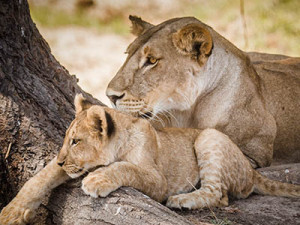
Ruaha is more remote than many popular safari destinations and safari parks in Tanzania, which has the wonderful benefit of limiting visitor numbers to serious safari enthusiasts. It offers a truly rewarding wilderness experience in a remote and compelling African bush environment.
Situated in central Tanzania, the park is a part of the 45 000km² Rungwa-Kizigo-Muhesi ecosystem. It is characterised by diverse landscapes of extraordinary beauty, ranging from rolling hills to groves of spiky baobab. The main feature of the area is the Great Ruaha River that flows along the southeastern margin for 160km through rugged gorges and open plains, and from which the park takes it name.
The valley of the Great Ruaha River is considered an extension of the Great Rift Valley, which crosses the park. Ruaha’s landscape ranges from river systems, natural springs, wetlands and kopjes to mountains and undulating hills that form a good habitat for animals such as klipspringer. Natural springs occurring throughout the park – associated with the base of the Western Rift Valley escarpment – are wildlife refuges in the dry season when the rivers run dry.
Over 1 650 plant species have been identified in Ruaha, which is characterised by semi-arid vegetation, baobab trees, acacia and other species. The park is the transitional point of two vegetation zones: the Zambezian (characterised by miombo vegetation) and Sudanian (characterised by acacia vegetation).
Lifeblood of the park
The park is currently facing a significant environmental challenge from the progressive drying up of the Great Ruaha River. The river used to flow all year round, but since 1993 there have been increasingly long periods every dry season in which it has dried up completely. Despite this, the park serves as a watershed both for wildlife and humans, and the river supports agricultural activities downstream and contributes to Tanzania’s hydroelectric power (HEP) at Mtera and Kidatu dams.

Game viewing in Ruaha National Park is unrivalled and the scope of wildlife extraordinary, with 80 animal species and 10% of the world’s lion population calling the plains home. Ruaha occupies a distinctive position, bridging the two different botanical regions of Eastern and Southern Africa. In some areas, the miombo woodlands typical of Zambia are dominant, while in others the dry open savannah of Kenya and Tanzania is common.
This diversity enhances wildlife observation opportunities: leopards are frequently spotted in dense woodlands, while lions and cheetahs wander the expansive plains, and elephants are seen quenching their thirst at the river.
The density of lions in the park is not only extremely high but prides are unusually large – it is not uncommon to see numbers of 20 or more. Here, nearly 100 elusive African wild dogs reside, with both black-backed jackals and hyenas boasting substantial populations. Buffalo, zebra, giraffe, Greater and Lesser kudu, Lichtenstein’s hartebeest, waterbuck, bushbuck, impala, and, not to forget, the 580 documented bird species are also frequently observed. In the height of dry season, see elephants obtain water from dry sand rivers using their front feet and trunks.
Asilia’s Kwihala Camp is renowned in East Africa for its excellent guides and proximity to the wild. Whether you’re tracking lions by vehicle, discovering the smaller wonders on foot or just relaxing in camp, the expert guides at Kwihala will enhance your wildlife experience with their vast knowledge.
Game drives
With 10% of the global population of lions living in Ruaha, the predators are never far away. A morning spent examining spoor and racing through the bush after these majestic animals is an exhilarating experience.
Wildlife photography
Our drivers are all extremely knowledgeable and know exactly how to place their vehicles for photographers. Sandbags for stability are available in our vehicles, which also have charging facilities.
Birding
The variety of birdlife in Ruaha is phenomenal with over 550 recorded species and an interesting mix of southern and northern varieties Take your binoculars and a bird guide, and prepare to be astounded by the number of species you can tick off the list.
Walking safaris
A guided walking safari in Ruaha is a truly intimate way to experience the beauty and magic of this wild park. The guiding is superb, and encountering game on foot gives you a fully immersive wilderness experience that is thrilling and memorable.
Night Drives
A guided night drive is a rare and valuable opportunity to encounter Africa’s elusive nocturnal animals.
If your prime interest is sightings of larger mammals and big cats, the best time to visit Ruaha National Park is the sunny dry season between June and October. As the rivers dry up, more animals congregate around remaining water sources. Of course, the apex predators are never far behind. June is also the Greater kudu breeding season, and so this is a good time to spot males.
The best time for avid birders to visit is during the long rains between February and April, when migrant birds visit the area. The wet season is also when the scenery is most lush and wildflowers are blooming, and the days are at their hottest.
Climate
- Dry season: June to October
- Start of rains: November to January
- Peak of wet season: February to March
- Max. temp. range during the day: 25ºC – 30ºC / 77ºF – 30ºF
- Min. temp. range during the evenings: 12ºC – 17ºC / 54ºF – 64ºF

